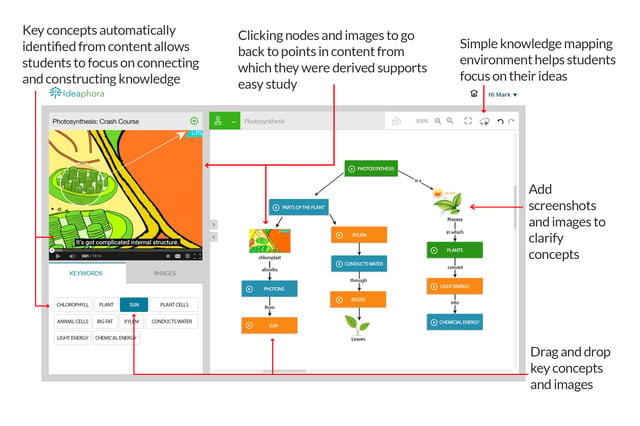SEMANTIC ANALYSIS AND HOW IT WORKS
Ideaphora is the only knowledge mapping tool that integrates with digital content, enabling users to directly grab concepts from online materials and place them into their maps. Learners don’t have to fumble with toggling among multiple screens, cutting and pasting, or generating nodes and text themselves.
The Ideaphora web-based knowledge-mapping environment uses semantic analysis to identify key concepts in online content, such as videos, eBooks, PDFs, and webpages. These key concepts are presented to learners and are easily accessed through a drag-and-drop interface to enable them to construct knowledge maps. Ideaphora’s semantic analysis process continually identifies, presents and refines key concepts in the knowledge-mapping environment.
Identifying Key Concepts
Information contained in speech transcripts of videos, PDF documents, HTML pages, and eBooks are first pre-processed to extract textual content and images. This includes breaking it down into sentences and words, removing common words, and annotating with proprietary tags. The metadata created by this process is passed to the Ideaphora “text-mining” engine for analysis.
The text-mining engine uses an ensemble of machine learning algorithms to analyze data received during the pre-processing stage. The engine extracts key concepts and relations between key concepts considered relevant within the context of the document and the corpus to which it belongs. The “corpus” can comprise a combination of content sources, and for example, as large as an entire grade’s textbooks with accompanying videos. Weights are then assigned to these key concepts to prioritize them for learner access.

Refining Key Concepts
Users are presented with the results of the analysis in Ideaphora. Learners choose key concepts as well as images to place in their knowledge maps and then make implicit and explicit connections between these concepts to construct knowledge. Ideaphora’s “knowledge” engine then examines user created connections and compares them with Ideaphora’s automatically generated data to improve the relevancy and accuracy of the key concepts presented. This is a continuous process that ensures users are presented with the best possible information, are making the correct conceptual connections, and are not distracted by unnecessary information.
The results of semantic analysis combined with other elements of Ideaphora’s learning environment allow learners to initiate knowledge creation without the “blank page” stress often associated with knowledge mapping and writing. Teacher and student feedback and data from classroom use of Ideaphora indicates that the tool increases student engagement with and deepens their understanding of curriculum content. Get the full story behind Ideaphora's technology, its research basis and education results in our new white paper.

